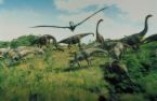How little we know about DINOSAURS

Hi.This is me. simple Jarrod.
I live in the city of Kuala Lumpur, (KL) the capital of Malaysia.
My school is in Ampang area where I get to learn 3 languages
Bahasa Malaysia, English and Mandarin.
I like science and I enjoy playing Counter Strike.
on line. When you see jarrod, that's me.
Feel free to play with me when you are on line.
my email is: [email protected]
World of Dinosaurs
t-rex tyrannosaurus
T. rex was one of the largest terrestrial carnivores of all time. It stood approximately 15 feet high and was about 40 feet in length, roughly six tons in weight. In its large mouth were six-inch long, sharp, serrated teeth.
Just about two dozen good specimens of these animals have been found and these finds are from highly restricted areas in western North America. Henry Fairfield Osborn, of the American Museum of Natural History in New York City, first described Tyrannosaurus rex in 1905. This first specimen of Tyrannosaurus is now on display at the Carnegie Museum of Natural History in Pittsburgh, Pennsylvania. The skeleton on display at UCMP is a cast of a skeleton (excavated in 1990) now in the Museum of the Rockies in Bozeman, Montana. Berkeley's mount is 90% complete, one of the best specimens found to date. Some 15–20 other specimens around the country range from about 10% to 80% complete; missing ribs and tail bones are common.

Paragraph.
A current topic in paleontology that has received much popular press is the question of whether T.rex (or other Tyrannosauridae in general) were predators or scavengers. Let's explore this issue. Paleontologist Jack Horner of the Museum of the Rockies (Bozeman, MT) has proposed that T.rex could not have been a predator. His arguments against predation include its small eyes (needed to see prey), small arms (needed to hold prey), huge legs (meaning slow speed) and that there is no evidence for predation — bones have been found with tyrannosaur teeth embedded in them or scratched by them, but so far no study has shown that tyrannosaurs killed other dinosaurs for food (a bone showing tyrannosaur tooth marks that had healed would be strong evidence for predation).
His evidence supporting scavenging include its large olfactory lobes (part of the brain used for smell), and that its legs were built for walking long distances (the thigh was about the size of the calf, as in humans). Vultures have large olfactory lobes and are good at soaring to cover long distances.
There are arguments against scavenging. Most large living predators (such as lions and hyenas) do scavenge meat happily when it is available, but most do prefer fresh meat. Horner argues that its arms were too weak to grab prey, but sharks, wolves, snakes, lizards and even many birds are successful predators without using their forelimbs (if any). Whether T.rex was a slow animal is tough to tell, as our dinosaur speeds page will tell you.
What is the public to think of all this? It is suggested that you make up your own mind; the fact is that reconstructing the behavior of extinct animals is difficult, especially when there are no close modern relatives with which to compare them. Tyrannosaurs may have been scavengers, predators or both; Horner is merely presenting an opposing argument that shows that we are not yet 100% sure what ecological niche the great tyrannosaurs filled.

The "duckbilled dinosaurs" were common in the Upper Cretaceous of Europe, Asia, and North America. They were members of the Ornithopoda, and close relatives and possibly descendants of the earlier iguanodontid dinosaurs. Early interpretations of fossil skin impressions suggested that hadrosaur feet were webbed. Recent hypotheses, more consistent with what we know about the structure of ornithopod feet, suggest that hadrosaurs had pads similar to those seen on camel feet. Their stiff tails, supported by ossified tendons, and their sturdy bones and rapidly replaced teeth suggest that hadrosaurs spent most of their time on land, though close to bodies of water, feeding on tough terrestrial plants. The discovery of spectacularly preserved hadrosaur nests and young shows that hadrosaurs migrated to nesting grounds to reproduce.
There are two subfamilies of hadrosaurs, the Lambeosaurinae, which have a crest on the skull (like the top skull at right), and the Hadrosaurinae, which lacked the crest (like the bottom skull at right). The crest on a lambeosaur's skull contains the nasal passages, which "looped" through the crest and often formed sizeable chambers before passing into the airway. Why the crest? A number of hypotheses have been seriously suggested:
the crest was a "snorkel" so that lambeosaurs could breathe while under water (but the crest had no opening to the outside, except for the nostrils);
the crest warmed the air that the lambeosaurs were breathing (but lambeosaurs already lived in warm climates);
the crest was an extra reservoir of air for swimming lambeosaurs (but it doesn't hold much air, and lambeosaurs probably didn't swim very much);
the crest enabled lambeosaurs to breathe fire from their nose (but there's no evidence that the delicate bones of the nose were ever exposed to high temperatures regularly).
Maiasaura lived in herds and it raised its young in nesting colonies. The nests, contained 30 to 40 eggs laid in a circular or spiral pattern. They were made of earth. The eggs were about the size of ostrich eggs.
The eggs were hatched by the heat resulting from rotting vegetation placed into the nest by the parents, rather than a parent sitting on the nest. Upon hatching, fossils of baby Maiasaura show that their legs were not fully developed and thus they were incapable of walking. Fossils also show that their teeth were partly worn, which means that the adults had to bring food to the nest.
The hatchlings grew from a size of 16 inches to 58 inches long in the span of their first year. At this point, or perhaps after another year, the animal left the nest. The hatchlings had different facial proportions from the adults, with larger eyes and a shorter snout.
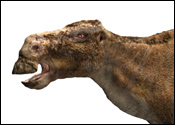
Maiasaura was large (about 7 meters long) and had the typical hadrosaurid flat beak and a thick nose. It had a small, spiky crest in front of its eyes. The form of the head resembled that of a horse.
This dinosaur was herbivorous. It walked both on two (bipedal) or four (quadrupedal) legs and appeared to have no defense against predators, except, perhaps, its heavy muscular tail and its herd behaviour. These herds were extremely large and could have comprised as many as 10,000 individuals.
spinosaurus

Spinosaurus (meaning "spine lizard") is a genus of theropod dinosaur which lived in what is now North Africa, from the Albian to early Cenomanian stages of the Cretaceous Period, about 100 to 93 million years ago. This genus was first known from Egyptian remains discovered in the 1910s and described by German paleontologist Ernst Stromer. These original remains were destroyed in World War II, but additional skull material has come to light in recent years. It is unclear whether one or two species are represented in the described fossils. The best known species is S. aegyptiacus from Egypt, although a potential second species, S. marocannus, has been recovered from Morocco.
The distinctive "spines" of Spinosaurus, which were long extensions of the vertebrae, grew up to 2 metres (6.6 ft) long and were likely to have had skin connecting them, forming a sail-like structure, although some authors have suggested that they were covered in muscle and formed a hump or ridge. Multiple functions have been put forward for this structure, including thermoregulation and display. According to recent estimates, Spinosaurus is the largest of all known carnivorous dinosaurs, even larger than Tyrannosaurus rex and Giganotosaurus. These estimates suggest that it was around 16 to 18 meters in length (52.5 to 59.1 ft) and 9 tonnes (9.9 tons) in weight,[1] although these figures have not been universally accepted.
The most distinctive characteristic of Dilophosaurus was the pair of rounded crests on its skull, probably used for display. Studies by Rob Gay (2001) show that these crests may have been larger in one sex than in the other. Another curious skull feature was a notch behind the first row of teeth, giving it an almost crocodile-like appearance. This "notch" existed by virtue of a weak connection between the premaxillary and maxillary bones of the skull. This conformation led to the early hypothesis that Dilophosaurus scavenged off dead carcasses, with the front teeth being too weak to bring down and hold large prey. A similar notch is present in most other species of coelophysoid.
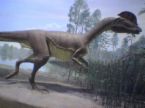
Dilophosaurus measured around 6 meters (20 ft) long and may have weighed half a ton. Fossils of the animal have been found at the Navajo Indian Reservation, just west of Tuba City, Arizona, USA. Just a few tens of feet below the level of the bones, large footprints of carnivorous dinosaurs were found and these may belong to Dilophosaurus. It lived in the Early Jurassic Period. Welles later redescribed the entire taxon in 1984, in a more comprehensive paper. Dilophosaurus may be a primitive member of the clade containing both ceratosaurian and tetanuran theropods. Alternatively, some paleontologists classify this genus as a large coelophysoid. Recent potential Dilophosaurus 'skin imprints', associated with a set of footprints, seemed to suggest that it had feathers but further study revealed these to be impressions of plant material.
utahraptor

Like other dromaeosaurids, Utahraptor had a huge curved claw on the second toe that could grow to 23 centimeters (almost 9 in) long. The animal may have grasped its prey with its forelimbs while kicking with its hindlimbs. Recent tests on reconstructions of the smaller Velociraptor suggest that claws of this type were used for stabbing or suffocating its prey, not slashing into their hide.[2] Up to 6.5 meters (22 ft) long, 2 meters (over 6 ft) tall, and 700 kilograms (1500 lb) in weight, Utahraptor[1]
It is thought that Utahraptor may be closely related to the much smaller Dromaeosaurus and the giant Mongolian dromaeosaurid Achillobator.[1] would have been a formidable predator.
triceratops

A full grown Triceratops measured about about 30 feet long, 10 feet tall (3 m), and weighed about 6-12 tons (weight estimates vary greatly for dinosaurs).
It was about twice the size of a rhinoceros. It had four short legs with three horns on it's face. Two long horns were above it's eyes and one short stubby horn on it's nose. It had flat teeth and a thrill on it's head that protected it's neck. It also had a large tail.
Young Earth Age:
Alive sometime in the last 6000 years.
Old Earth Age:
According to old earth scientists, Triceratops lived in the late Cretaceous Period, about 65-72 million years ago.
Diet:
It was a herbivore (plant eating dinosaur).
Fossil locations:
Ankylosaurus fossils have been found in the Wyoming, Montana, South Dakota , Colorado, and Canada (Alberta, Saskatchewan).
Classification:
Ceratopsia
Giganotosaurus carolinii was named for Ruben Carolini, an amateur fossil hunter, who discovered the fossils in the deposits of the Rio Limay Formation of Patagonia, southern Argentina, in 1993. It was published by Rodolfo Coria and Leonardo Salgado in the journal Nature in 1995.[2]
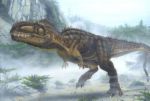
(meaning 'giant southern lizard', derived from the Ancient Greek gigas/γιγας meaning 'giant', notos/νοτος meaning 'south wind' and saurus/σαυρος meaning 'lizard')[1] was a genus of carcharodontosaurid dinosaur that lived 93 to 89 million years ago during the Turonian stage of the Late Cretaceous Period. It is one of the largest known terrestrial carnivores, larger than Tyrannosaurus, but smaller than Spinosaurus. Its fossils have been found in Argentina.
dinosaur fossils

A British fossil finder and ecclesiastic, William Buckland (1784-1856), discovered the first dinosaur fossil remains of our modern times. In 1819, Buckland discovered the Megalosaurus Bucklandii (Buckland's Giant Lizard) in England. It was given its name in 1824. Prior to this, Reverend Plot had found a huge femur bone as early as 1676 in England. It was thought to belong to a giant. R. Brookes published a report on Plot's find in 1763. Authorities suggest it may actually have belonged to a dinosaur. However, with the discovery of giant human skeletal remains ranging from 8 feet to 12 feet-tall around the world in the last few hundred years, many believe the Plot femur may have belonged to a very tall human. In 1838, William Parker Foulke found the first (nearly) complete dinosaur fossil remains in New Jersey, USA. Since Buckland's original discovery in 1819, approximately 330 different dinosaur genera have been discovered thus far.
albertosaurus
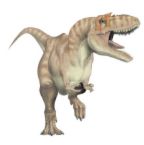
pronounced /ælˌbɝtoʊˈsɔrəs/; meaning "Alberta lizard") is a genus of tyrannosaurid theropod dinosaurNorth America during the Late Cretaceous Period, more than 70 million years ago. The type species, A. sarcophagus, was restricted in range to the modern-day Canadian province of Alberta, after which the genus is named. Scientists disagree on the content of the genus, with some recognizing Gorgosaurus libratus as a second species. As a tyrannosaurid, Albertosaurus was a bipedalpredator with tiny, two-fingered hands and a massive head with dozens of large, sharp teeth. It may have been at the top of the food chain in its local ecosystem. Although relatively large for a theropod, Albertosaurus was much smaller than its more famous relative Tyrannosaurus, probably weighing less than 2 metric tons.
Fossils of more than thirty individuals have been recovered, providing scientists with a more detailed knowledge of Albertosaurus anatomy than is available for most other tyrannosaurids. The discovery of 22 individuals at one site provides evidence of pack behavior and allows studies of ontogeny and population biology which are impossible with lesser-known dinosaurs. that lived in western.
torvosaurus

Torvosaurus (pronounced /ˌtɔrvoʊˈsɔrəs/ TOR-vo-SOR-us) is a genus of giant carnivorous dinosaur, relatively similar in appearance to Tyrannosaurus although it had larger 'arms' and a bulky body. It lived about 145 million years ago, in the late Jurassic Period of what is now North America and Portugal. It reached 9 to 11 meters (30 to 36 ft) in length and an estimated weight of about 2 metric tonstons), which made it the largest carnivore of its time, except for possibly Epanterias (perhaps just a big Allosaurus) and Saurophaganax.
It was first discovered by James A. Jensen and Kenneth Stadtman in the rocks of the Morrison Formation at the Dry Mesa Quarry, Colorado in 1972. The genus and the type species T. tanneri were named and described in 1979 by Peter M. Galton and Jensen. The name Torvosaurus means 'savage lizard' from the Latin torvus meaning 'savage' and the Greek sauros meaning 'lizard'). (2.2
oviraptor
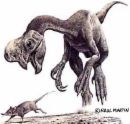
Oviraptor is a genus of small Mongolian theropod dinosaur, first discovered by legendary paleontologistRoy Chapman Andrews, and first described by Henry Fairfield Osborn, in 1924. Its name is Latin for 'egg seizer', referring to the fact that the first fossil specimen was discovered atop a pile of what were thought to be Protoceratops eggs, and the specific name philoceratops means "lover of ceratopsians", also given as a result of this find. In his 1924 paper, Osborn explained that the name was given due to the close proximity of the skull of Oviraptor to the nest (it was separated from the eggs by only four inches of sand). However, Osborn also suggested that the name Oviraptor "may entirely mislead us as to its feeding habits and belie its character."[1] In the 1990s, the discovery of nesting oviraptorids like Citipati proved that Osborn was correct in his caution regarding the name. These finds showed that the eggs in question probably belonged to Oviraptor itself, and that the specimen was actually brooding its eggs.
Oviraptor lived in the late Cretaceous Period, during the Santonian stage, and may have lived in an earlier stage called the Campanian, between 80 to 70 million years ago; it comes almost exclusively from the Djadokhta Formation of Mongolia, as well as the northeast region of the Neimongol Autonomous Region of China, in an area called Bayan Mandahu.
ankylosaurus
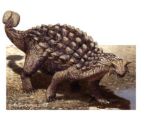
was a very large animal, compared to the majority of modern land animals. Some scientists have estimated a length of 9 meters (30 ft.).[1] Another reconstruction suggests a significantly smaller size, at 6.25 m (20.5 ft) long, up to 1.5 m (5 ft) wide and about 1.7 m (5.5 ft) high at the hip. The body shape was low-slung and quite wide. Ankylosaurus was quadrupedal, with the hindlimbs longer than the forelimbs. Although its feet are still unknown to science, comparisons with other ankylosaurids suggest Ankylosaurus probably had five toes on each foot. The skull was low and triangular in shape, wider than it was long. The largest known skull measures 64.5 centimeters (25 in) long and 74.5 cm (29 in) wide. Like other ankylosaurs, Ankylosaurus was herbivorous, with small, leaf-shaped teeth suitable for cropping vegetation. Ankylosaurus did not share the grinding tooth batteries of the contemporaneous ceratopsid and hadrosaurid dinosaurs, indicating that very little chewing occurred. Bones in the skull and other parts of the body were fused to increase their strength.
ceratosaurus

pronounced /ˌsɛrətəˈsɔrəs/) meaning 'horned lizard', in reference to the horn on its nose (Greekkeras/keratos meaning 'horn' and sauros meaning 'lizard'), was a large predatory dinosaur from the Late Jurassic Period, found in the Morrison Formation of North America, in Tanzania and Portugal. It was characterized by large jaws with blade-like teeth, a large, blade-like horn on the snout and a pair hornlets over the eyes. The forelimbs were powerfully built but very short. The bones of the sacrum were fused (synsacrum) and the pelvic bones were fused together and to this structure (Sereno 1997) (i.e. similar to modern birds). A row of small osteoderms was present down the middle of the back.
cryolophosaurus
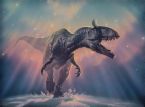
Cryolophosaurus was about 6 to 8 meters (20 to 26 feet) long, which is significantly smaller than the largest Allosaurus, which reached up to 12 meters (40 feet) in length.
A high, narrow skull was discovered, 65 centimeters (25 inches) long. The peculiar nasal crest runs just over the eyes, where it rises up, perpendicular to the skull and fans out. It is furrowed, giving it a comb-like appearance. It is an extension of the skull bones, near the tear ducts, fused on either side to horns which rise from the eye sockets (orbital horns). While other theropods like the Monolophosaurus
The crest is too fragile to be used in combat, so it was probably used in mating displays. have crests, they usually run along the skull instead of across it.
kentrosaurus

The 1909–1912 German expedition to East Africa resulted in the discovery of several new dinosaur species, of which Kentrosaurus was one of the most important, for the reason outlined above — it implied a former proximity of Tanzania to the Morrison Formation, in the eastern part of the Rocky Mountains. Of the three paleontologists on this expedition, it was Edwin Hennig who first described Kentrosaurus, in 1915. An almost-complete skeleton was at one time recovered and mounted in the Humboldt Museum, of the University of Berlin but the museum was bombed during World War II and many specimens were lost.
chasmosaurus

Chasmosaurus fossils were first recovered in 1902 but were thought to be from a previously-known short-frilled ceratopsian - Monoclonius. However, in 1913, Charles Sternberg and his sons found several complete skulls of what is now known as Chasmosaurus, in Alberta, Canada. These were finally described in 1914, by Lawrence M. Lambe of the Geological Survey of Canada. Since that date, more skulls have been found. There are some differences across these skulls, detailed below.
There are a number of known species of Chasmosaurus. Lambe's original C. belli ('Bell's cleft lizard') was joined by C. canadensis ('chasm lizard from Canada') in the same year. The latter species had been described as Eoceratops canadensis by Lambe but was later reclassified as a chasmosaur by Lehman. Lull named an unusual, short-muzzled skull, collected in 1926, C. brevirostris. C. M. Sternberg added C. russelli, in 1940, from southwestern Alberta. The most recently described species is C. irvinensis, which stems from the uppermost beds of the Dinosaur Park Formation.
stegosaurus

Stegosaurus (IPA: /ˌstɛgəˈsɔrəs/) is a genus of stegosaurid armoured dinosaur from the Late Jurassicperiod (Kimmeridgian to Early Tithonian) in what is now western North America. In 2006, a specimen of Stegosaurus was announced from Portugal, suggesting that they were present in Europe as well.[1]tail spikes and plates, Stegosaurus is one of the most recognizable dinosaurs, along with Tyrannosaurus, Triceratops, and Apatosaurus. The name Stegosaurus means "roof-lizard" and is derived from the Greek στέγος-, stegos- ("roof") and σαῦρος, -sauros ("lizard").[2] At least three species have been identified in the upper Morrison Formation and are known from the remains of about 80 individuals. They lived some 155 to 145 million years ago, in an environment and time dominated by the giant sauropods Diplodocus, Camarasaurus, and Apatosaurus. A large, heavily-built and herbivorousquadruped, Stegosaurus had a distinctive and unusual posture, with a heavily-arched back, short forelimbs, head held low to the ground and a stiffened tail held high in the air. Its array of plates and spikes have been the subject of much speculation. The spikes were most likely used for defense, while the plates have also been proposed as a defensive mechanism, as well as having display and thermoregulatory (heat control) functions. Stegosaurus was the largest of all the stegosaurians (bigger than genera such as Kentrosaurus and Huayangosaurus) and, although roughly bus-sized, it nonetheless shared many anatomical features (including the tail spines and plates) with the other stegosaurian genera. Due to its distinctive
pteranadon

Unlike earlier pterosaurs such as Rhamphorhynchus and Pterodactylus, Pteranodon had toothless beaks, like modern birds.
Pteranodon fossils have been generally found in the Cretaceous chalk beds of Kansas. These chalk beds were deposited at the bottom of what was once an epicontinental seaway on what is now the North American continent. The first Pteranodon skull was found on May 2, 1876, in the Smoky Hill River in Wallace County, Kansas, USA, by S. W. Williston, a fossil collector working for Othniel Marsh. The Niobrara Formation is possibly the most famous unit here, and other fossils found in this formation include those of sea turtles, mosasaurs, and early birds.[1]
Pteranodon were reptiles, but not dinosaurs. By definition, all dinosaurs were diapsid reptiles with an upright stance, and consist of the group containing saurischians and ornithischians. While the advanced pterodactyloid pterosaurs (like Pteranodon) had a semi-upright stance, it evolved independently of the upright stance in dinosaurs, and pterosaurs lacked the distinctive adaptations in the hip associated with the dinosaurian posture. However, dinosaurs and pterosaurs may have been closely related, and most paleontologists place them together in the group Ornithodira, or "bird necks".
amargasaurus
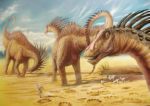
pronounced /əˌmɑrgəˈsɔrəs/; "La Amarga lizard") is a genus of dicraeosaurid sauropod dinosaur from the Early Cretaceous Period of what is now South America. It was small for a sauropod, reaching 10 metersfeet) length. It would have been a quadrupedal herbivore with a long, low skull on the end of a long neck, much like its relative Dicraeosaurus. However, this dinosaur sported two parallel rows of tall spines down its neck and back, taller than in any other known sauropod. These spines have been reconstructed supporting skin sails, but the "skin sail" hypothesis was rejected by Gregory S. Paul in 2000. (33
parasaurolophus

Parasaurolophus (pronounced /ˌpærəsɔˈrɒləfəs/, in common usage also /ˌpærəˌsɔrəˈloʊfəs/; meaning "near crested lizard" in reference to Saurolophus) is a genus of ornithopod dinosaur from the Late Cretaceous Period of what is now North America, about 76-73 million years ago. It was a herbivore that walked both as a biped and a quadruped. Three species are recognized: P. walkeri (the type species), P. tubicen, and the short-crested P. cyrtocristatus. Remains are known from Alberta (Canada), and New Mexico and Utah (USA). It was first described in 1922 by William Parks from a skull and partial skeleton in Alberta.
Parasaurolophus is a hadrosaurid, part of a diverse family of Cretaceous dinosaurs known for their range of bizarre head adornments. This genus is known for its large, elaborate cranial crest, which at its largest forms a long curved tube projecting upwards and back from the skull. Charonosaurus from China, which may have been its closest relative, had a similar skull and potentially a similar crest. The crest has been much discussed by scientists; the consensus is that major functions included visual recognition of both species and sex, acoustic resonance, and thermoregulation. It is one of the rarer duckbills, known from only a handful of good specimens.
baryonyx

Baryonyx (pronounced /ˌbæriːˈɒnɪks/ meaning "heavy claw", referring to its large claw (Greek barusonyx meaning 'claw' or 'nail') was a carnivorous dinosaur discovered in clay pits just south of Dorking, England, and northern Spain. The major part of the skeleton of a juvenile specimen was found in England, while the Spanish fossils consist mainly of a partial skull and some fossil tracks. It has been dated to the Barremian period of Early Cretaceous Period, around 125 million years ago.
Baryonyx is one of the few known piscivorous (fish-eating) dinosaurs, with specialized adaptions like a long low snout with narrow jaws filled with finely serrated teeth and gaffe hook-like claws to help it hunt its main prey. meaning 'heavy' and
acrocanthosaurus

Acrocanthosaurus (pronounced /ˌækrəˌkænθəˈsɔrəs/ or ak-ro-KAN-tho-SAWR-us; meaning 'high-spined lizard') is a genus of allosauroid theropod dinosaur that existed in what is now North America during the mid-Cretaceous Period, approximately 125 to 100 million years ago. Like most dinosaur genera, Acrocanthosaurus contains only a single species, A. atokensis. Its fossil remains are found mainly in the U.S. states of Oklahoma and Texas, although teeth attributed to Acrocanthosaurus have been found as far east as Maryland.
Acrocanthosaurus was a bipedal predator. As the name suggests, it is best known for the high neural spines on many of its vertebrae, which most likely supported a ridge of muscle over the animal's neck, back and hips. Acrocanthosaurus was one of the largest theropods, approaching 12 meters (40 ft) in length, and weighing up to about 2.40 metric tons (2.65 short tons). Large theropod footprints discovered in Texas may have been made by Acrocanthosaurus, although there is no direct association with skeletal remains.
Recent discoveries have elucidated many details of its anatomy, allowing for specialized studies focusing on its brain structure and forelimb function. However, there is still debate over its evolutionaryallosaurid, and others as a carcharodontosaurid. Acrocanthosaurus was the largest theropod in its ecosystem and likely an apex predator which possibly preyed on large sauropods and ornithopods. relationships, with some scientists classifying it as an
saltasaurus

Saltasaurus (which means "lizard from Salta") is a genus of sauropod dinosaur of the Late CretaceousPeriod. Relatively small among sauropods, though still massive by human standards, it was characterized by a diplodocid-like head (with blunt teeth, only in the back of the mouth) and was the first discovered with small bony plates embedded in its skin. The bony plates (a form of armour called osteoderms) have since been found in other titanosaurids, and a crest of scutes has also been discovered, running down the back of diplodocids. When the plates of a saltosaur were originally found, independently of skeletal remains, they were assumed to be from an ankylosaurian, whose plates they resemble.
The word "Saltasaurus" is occasionally spelled "Saltosaurus", even by palaeontologists. Saltasaurus may also be confused with Saltopus, because of the similarity between their names, although the two genera are quite unlike each other. Saltasaurus is also to be distinguished from Saltoposuchus.
apatosaurus

Apatosaurus (IPA: /əˌpætəˈsɔrəs/), popularly (though incorrectly) known as Brontosaurus, is a genussauropod dinosaur that lived about 140 million years ago, during the Jurassic Period. It was one of the largest land animals that ever existed, with an average length of 23 meters (75 ft) and a mass of at least 23 metric tons (25 short tons). The name Apatosaurus means 'deceptive lizard', so-given because the chevron bones were similar to those of Mosasaurus (Greek ἀπατέλος or ἀπατέλιος meaning 'deceptive' and σαῦρος meaning 'lizard').
The cervical vertebrae were less elongated and more heavily constructed than those of Diplodocus and the bones of the leg were much stockier (despite being longer), implying a more robust animal. The tail was held above the ground during normal locomotion. Like most sauropods, Apatosaurus had only a single large claw on each forelimb, with the first three toes on the hindlimb possessing claws. of
ouranosaurus

Ouranosaurus was once believed to have had a large sail on its back, supported by thick long spines, that spanned its entire back and tail, like Spinosaurus, a well-known meat-eating dinosaur that lived around the same time, and the older Dimetrodon of the Permian period. In fact, the tall neural spines did not closely resemble those of sail-backs such as Spinosaurus. The supporting spines in a sailback become thinner distally, whereas in Ouranosaurus the spines actually become thicker distally. The spines were also bound together by tendons, which stiffened the back. Finally, the spine length peaks over the forelimbs. All of these features indicate that the dinosaur may have had a hump, resembling that of a bison or camel, rather than a sail.
gallimimus

Gallimimus (pronounced /ˌɡælɨˈmaɪməs/ GAL-i-MYE-mus) , meaning 'fowl mimic', is a genus of ornithomimosaurid dinosaur from the late Cretaceous Period (Maastrichtian stage) Nemegt Formation of Mongolia. With a maximum length of 4 to 6 meters (13-20 feet) and weighing as much as 440 kilogramspounds), it was one of the largest ornithomimosaurs. Gallimimus is known from multiple individuals, ranging from juvenile (about 0.5 metres tall at the hip) to adult (about 2 metres tall at the hip).
The fossil remains of this dinosaur were discovered in the early 1970s in the Gobi Desert of Mongolia. In 1972, it was named by paleontologists Rinchen Barsbold, Halszka Osmólska, and Ewa Roniewicz. The only known species is Gallimimus bullatus. A supposed second species, "Gallimimus mongoliensis", has never been formally referred to this genus. A recent reanalysis of the nearly complete skeleton of Gallimimus mongoliensis concluded that it is not a species of Gallimimus but may represent a new, currently unnamed ornithomimid genus. (970
daspletosaurus

Daspletosaurus (pronounced /dæsˌpliːtoʊˈsɔrəs/ or das-PLEET-o-SAWR-us; meaning 'frightful lizard') is a genus of tyrannosaurid theropod dinosaur that lived in western North America between 80 and 73 million years ago, during the Late Cretaceous Period. Fossils of the only named species (D. torosus) were found in Alberta, although other possible species from Alberta, Montana and New Mexico await description. Including these undescribed species, Daspletosaurus is the most species-rich genus of tyrannosaur.
Daspletosaurus is closely related to the much larger and more recent Tyrannosaurus. Like most known tyrannosaurids, it was a multi-ton bipedal predator equipped with dozens of large, sharp teeth. Daspletosaurus had the small forelimbs typical of tyrannosaurids, although they were proportionately longer than in other genera.
As an apex predator, Daspletosaurus was at the top of the food chain, probably preying on large dinosaurs like the ceratopsid Centrosaurus and the hadrosaur Hypacrosaurus. In some areas, Daspletosaurus coexisted with another tyrannosaurid, Gorgosaurus, though there is some evidence of niche differentiation between the two. While Daspletosaurus fossils are rarer than other tyrannosaurids, the available specimens allow some analysis of the biology of these animals, including social behavior, diet and life history.
saichania

Saichania (Mongolian meaning 'beautiful one') is a genus of ankylosaurid dinosaur from the Late Cretaceous Period. It was found in the Barun Goyot Formation at Khulsan in the Nemegt Basin, southern Mongolia. It lived during the Campanian alongside Pinacosaurus. Saichania was about six meters long. The type species is Saichania chulsanensis.
Saichania was described by Teresa Maryańska in 1977, along with Tarchia kielanae.[1] The type specimen of S. chulsanensis consists of a skull and the anterior part of the postcranial skeleton (neck and back vertebrae, shoulder girdle, forelimb, and some armour in life position). Referred specimens include a fragmentary skull roof and associated armour, and an undescribed, almost complete skeleton with skull (see picture).
styracosaurus

Styracosaurus (pronounced /stɪˌrækəˈsɔrəs/, meaning "spiked lizard" from Greek styrax/στυραξ 'spike at the butt-end of a spear-shaft' and saurus/σαυρος 'lizard')[1] was a genus of herbivorous ceratopsiandinosaur from the Cretaceous Period (Campanian stage), about 76.5 to 75.0 million years ago. It had four to six long horns extending from its neck frill, a smaller horn on each of its cheeks, and a single horn protruding from its nose, which may have reached dimensions of around 60 centimeters (2 ft) long and 15 centimeters (6 in) wide. The function or functions of the horns and frills have been the subject of debate for many years.
Styracosaurus was a large dinosaur, reaching lengths of 5.5 meters (18 ft) and weighing nearly 3 tons. It stood about 1.8 meters (6 ft) tall. Styracosaurus possessed four short legs and a bulky body. Its tail was rather short. It also had a beak and flat cheek teeth, indicating that its diet was herbivorous. Like other ceratopsians, this dinosaur may have been a herd animal, traveling in large groups, as suggested by bonebeds.
Named by Lawrence Lambe in 1913, Styracosaurus is a member of the Centrosaurinae. Two species, S. albertensis and S. ovatus are currently assigned to Styracosaurus. Other species assigned to the genus have since been reassigned elsewhere.
conchoraptor

Conchoraptor (meaning "conch thief") was an oviraptorid dinosaur from the late Cretaceous Period of what is now Asia. Its name reflects the hypothesis that oviraptorids, rather than preying primarily upon eggs as had been traditionally thought, may have been specialized to feed on mollusks. Unlike many other oviraptorids, it didn't have a crest and was relatively small.
The type species, Conchoraptor gracilis, was described by Barsbold, in 1986. At first scientists believed that Conchoraptor was a juvenile Oviraptor and that the animal's missing crest would have grown upon reaching sexual maturity. Further study of multiple skeletons showed that Conchoraptor belonged in a new genus. The hands of the animal were a major reason the conclusion was reached. Anatomically they seemed to be an evolutionary intermediate between an Ingenia-like animal and Oviraptor.
torosaurus

Two Torosaurus skulls were discovered in southeastern Wyoming by John Bell Hatcher in 1891 and the species was subsequently named by Othniel Charles Marsh in 1891, two years after Triceratops.
Remains have since been found in Wyoming, Montana, South Dakota, North Dakota, Utah and Saskatchewan. Some fragmentary remains, which may be Torosaurus, have been found in the Big BendTexas and in the San Juan Basin of New Mexico. Fossil evidence suggests it may have been uncommon; remains of its relative Triceratops are more frequently found.
Torosaurus species:
T. latus Region of Marsh, 1891 (type species)
Misassignments:
T. gladius Marsh, 1891 (=T. latus)
T. utahensis Lawson, 1976 (=T. latus)
(NB: The last species was originally described as Arrhinoceratops utahensis by Gilmore in 1946. Review by Sullivan et al. in 2005[1] has left it as Torosaurus utahensis and somewhat older than T. latus.
Although the name Torosaurus is frequently translated as 'bull lizard' (from the Latin 'taurus' (bull), it probably means 'perforated lizard' (from the Greek word 'toreo' (pierce, perforate).[2] The name refers to the holes, or fenestrae, in the frill of this animal. This was probably intended by Othniel Charles Marsh (the original namer) to contrast with the condition in Triceratops, which had a solid frill. Much of this confusion results from the fact that Marsh never explicitly gave the etymology of the name in his papers.
